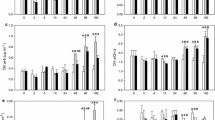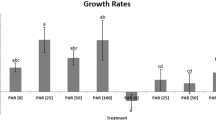Abstract
The effect of glyphosate herbicide at concentrations of 25, 100, 150 and 200 μg.L−1 on growth characteristics of diatoms C. caspia and T. weissflogii under accumulative growth conditions was investigated. Increasing herbicide concentration in the medium resulted in growth suppression of both species and decreased the final abundance of the cultures in the stationary growth phase. The calculated concentrations of herbicide EC10 and EC50 (10 and 90 μg.L−1 for C. caspia and 7 and 25 μg·L−1 for T. weissflogii, respectively) led to a 10 and 50% reduction in the abundance of the studied cultures relative to the control, are ecologically significant and correspond to the values recorded in aquatic areas. The combined effect of light (in the range of 20–250 µE.m−2.s−1) and glyphosate (calculated concentrations of EC10 and EC50) on the growth characteristics of microalgae was evaluated. An increase in algal sensitivity to light was observed with glyphosate exposure. In both species, the increase in the concentration of glyphosate in the medium led to a decrease in the initial angle of slope of the light curve of growth under conditions of light limitation, a reduction in the value of light saturation of growth, narrowing of the boundaries of the light optimum and an increase in the degree of light inhibition. It is shown that the effect of the combined action of light and glyphosate exceeds the sum of the effects of each factor. This fact should be taken into account in ecotoxicological monitoring when assessing the risks of glyphosate ingress into aquatic ecosystems. An increase in glyphosate concentration in water during periods with high values of solar insolation is potentially dangerous due to a decrease in the photosynthetic activity of algae and a reduction in diatom algae abundance.


Similar content being viewed by others
References
Akimov AI, Solomonova ES (2019) Characteristics of growth and fluorescence of certain types of algae during acclimation to different temperatures under culture conditions. Oceanology 59:316–326. https://doi.org/10.1134/S0001437019030019
Battaglin WA, Meyer MT, Kuivila KM, Dietze JE (2014) Glyphosate and its degradation product AMPA occur frequently and widely in US soils, surface water, groundwater, and precipitation. J Am Water Resour Assoc 50(2):275–290. https://doi.org/10.1111/jawr.12159
Baxter L, Brain RA, Lissemore L, Solomon KR, Hanson ML, Prosser RS (2016) Influence of light, nutrients, and temperature on the toxicity of atrazine to the algal species Raphidocelis subcapitata: Implications for the risk assessment of herbicides. Ecotoxicol Environ Saf 132:250–259. https://doi.org/10.1016/j.ecoenv.2016.06.022
Bonnineau C, Sague IG, Urrea G, Guasch H (2012) Light history modulates antioxidant and photosynthetic responses of biofilms to both natural (light) and chemical (herbicides) stressors. Ecotoxicology 21:1208–1224. https://doi.org/10.1007/s10646-012-0876-5
Cakmak I, Yazici A, Tutus Y, Ozturk L (2009) Glyphosate reduced seed and leaf concentrations of calcium, manganese, magnesium, and iron in non-glyphosate resistant soybean. Eur J Agron 31(3):114–119. https://doi.org/10.1016/j.eja.2009.07.001
Carvalho FP (2017) Pesticides, environment, and food safety. Food Energy Secur 6(2):48–60. https://doi.org/10.1002/fes3.108
Chalifour A, Spear PA, Boily MH, DeBlois C, Giroux I, Dassylva N, Juneau P (2009) Assessment of toxic effects of pesticide extracts on different green algal species by using chlorophyll a fluorescence. Toxicol Environ Chem 91(7):1315–1329. https://doi.org/10.1080/02772240802590293
Debenest T, Silvestre J, Coste M, Pinelli E (2010) Effects of pesticides on freshwater diatoms. Rev Environ Contam Toxicol 87–103 https://doi.org/10.1007/978-1-4419-1352-4_2
Deblois CP, Dufresne K, Juneau P (2013) Response to variable light intensity in photoacclimated algae and cyanobacteria exposed to atrazine. Aquat Toxicol 126:77–84. https://doi.org/10.1016/j.aquatox.2012.09.005
Du J, Izquierdo D, Xu HF, Beisner B, Lavaud J, Ohlund L, Lekha S, Juneau P (2023) Responses to herbicides of Arctic and temperate microalgae grown under different light intensities. Environ Pollut 333:121985. https://doi.org/10.1016/j.envpol.2023.121985
Edwards KF, Thomas MK, Klausmeier CA, Litchman E (2015) Light and growth in marine phytoplankton: allometric, taxonomic, and environmental variation. Limnol Oceanogr 60(2):540–552. https://doi.org/10.1002/lno.10033
Falkowski PG, Raven JA (2007) Aquatic photosynthesis, vol 484. Princeton University Press.
Finkel ZV, Beardall J, Flynn KJ, Quigg A, Rees TAV, Raven JA (2010) Phytoplankton in a changing world: cell size and elemental stoichiometry. J Plan Res 32(1):119–137. https://doi.org/10.1093/plankt/fbp098
Flores F, Stapp LS, van Dam J, Fisher R, Kaserzon S, Negri AP (2024) Toxicity of herbicides to the marine microalgae Tisochrysis lutea and Tetraselmis sp. Sci Rep 14(1):1727. https://doi.org/10.1038/s41598-024-51401-3
Gomes MP, Juneau P (2017) Temperature and light modulation of herbicide toxicity on algal and cyanobacterial physiology. Front Environ Sci 5:50. https://doi.org/10.3389/fenvs.2017.00050
Guasch H, Sabater S (1998) Light history influences the sensitivity to atrazine in periphytic algae. J Phycol 34(2):233–241. https://doi.org/10.1046/j.1529-8817.1998.340233.x
Jochem FJ (2000) Probing the physiological state of phytoplankton at the single-cell level. Sci Mar 64(2):183–195. https://doi.org/10.3989/scimar.2000.64n2183
Kabanova YG (1961) On the cultivation of marine planktonic diatoms and peridinium algae in laboratory conditions. Trudy IO AN SSSR 47:203–216.
Kaeoboon S, Suksungworn R, Sanevas N (2021) Toxicity response of Chlorella microalgae to glyphosate herbicide exposure based on biomass, pigment contents and photosynthetic efficiency. Plant Sci Today 8(2):293–300. https://doi.org/10.14719/pst.2021.8.2.1068
Kells JJ, Rieck CE (1979) Effects of illuminance and time on accumulation of glyphosate in johnsongrass (Sorghum halepense). Weed Sci 27(2):235–7. https://doi.org/10.1017/S0043174500043897
Klátyik S, Takács E, Barócsi A, Lenk S, Kocsányi L, Darvas B, Székács A (2024) Hormesis, the individual and combined phytotoxicity of the components of glyphosate-based formulations on algal growth and photosynthetic activity. Toxics 12(4):257. https://doi.org/10.3390/toxics12040257
Larras F, Lambert AS, Pesce S, Rimet F, Bouchez A, Montuelle B (2013) The effect of temperature and a herbicide mixture on freshwater periphytic algae. Ecotoxicol Environ Saf 98:162–170. https://doi.org/10.1016/j.ecoenv.2013.09.007
Litchman E, Klausmeier CA, Miller JR, Schofield OM, Falkowski PG (2006) Multi-nutrient, multi-group model of present and future oceanic phytoplankton communities. Biogeosciences 3(4):585–606. https://doi.org/10.5194/bg-3-585-2006
Maclntyre HL, Kana TM, Anning T, Geider RJ (2002) Photoacclimation of photosynthesis irradiance response curves and photosynthetic pigments in microalgae and cyanobacteria 1. J Phycol 38(1):17–38. https://doi.org/10.1046/j.1529-8817.2002.00094.x
Masiunas JB, Weller SC (1988) Glyphosate activity in potato (Solanum tuberosum) under different temperature regimes and light levels. Weed Sci 36(2):137–40. https://doi.org/10.1017/S0043174500074610
Mayasich JM, Karlander EP, Terlizzi DE (1986) Growth responses of Nannochloris oculata droop and Phaeodactylum tricornutum Bohlin to the herbicide atrazine as influenced by light intensity and temperature. Aquat Toxicol 8(3):175–184. https://doi.org/10.1016/0166-445X(86)90063-9
Mayer P, Frickmann J, Christensen ER, Nyholm N (1998) Influence of growth conditions on the results obtained in algal toxicity tests. Environ Toxicol Chem 17(6):1091–1098. https://doi.org/10.1002/etc.5620170615
Moosavi-Nai H, Dore J (1979) Factors affecting glyphosate activity in Imperata cylindrica (L.). II. Effect of shade. Weed Res 19:321–327
Moreno-Garrido I, Lubián LM, Soares AM (2000) Influence of cellular density on determination of EC50 in microalgal growth inhibition tests. Ecotoxicol Environ Saf 47(2):112–116. https://doi.org/10.1006/eesa.2000.1953Getrightsandcontent
Narayanan M, Devarayan K, Verma M, Selvaraj M, Ghramh HA, Kandasamy S (2024) Assessing the ecological impact of pesticides/herbicides on algal communities: a comprehensive review. Aquat Toxicol 106851. https://doi.org/10.1016/j.aquatox.2024.106851
Ostera JM, Malanga G, Puntarulo S (2020) Assessment of oxidative balance in hydrophilic cellular environment in Chlorella vulgaris exposed to glyphosate. Chemosphere 248:125955. https://doi.org/10.1016/j.chemosphere.2020.125955
Peng J, Yuan JP, Wu CF, Wang JH (2011) Fucoxanthin, a marine carotenoid present in brown seaweeds and diatoms: Metabolism and bioactivities relevant to human health. Mar Drugs 9(10):1806–1828. https://doi.org/10.3390/md9101806
Rodríguez-Bolaña C, Pérez-Parada A, Tesitore G, Goyenola G, Kröger A, Pacheco M, Gérez N, Berton A et al. (2023) Multicompartmental monitoring of legacy and currently used pesticides in a subtropical lake used as a drinking water source (Laguna del Cisne, Uruguay). Sci Total Environ 874:162310. https://doi.org/10.1016/j.scitotenv.2023.162310
Sandmann G, Römer S, Fraser PD (2006) Understanding carotenoid metabolism as a necessity for genetic engineering of crop plants. Metab Eng 8:291. https://doi.org/10.1016/j.ymben.2006.01.005
Sherrick SL, Holt HA, Hess FD (1986) Effects of adjuvants and environment during plant development on glyphosate absorption and translocation in field bindweed (Convolvulus arvensis). Weed Sci 34(6):811–6. https://doi.org/10.1017/S004317450006793X
Siehl D (1997) Inhibitors of EPSPS synthase, glutamine synthetase and histidine synthesis. In: Roe R, Burton J, Kuhr R (eds) Herbicide activity: toxicology, biochemistry and molecular biology. IOS Press, Amsterdam, p 37
Stachowski-Haberkorn S, Becker B, Marie D, Haberkorn H, Coroller L, De La Broise D (2008) Impact of Roundup on the marine microbial community, as shown by an in situ microcosm experiment. Aquat Toxicol 89(4):232–241. https://doi.org/10.1016/j.aquatox.2008.07.004
Tanpipat S, Adkins SW, Swarbrick JT, Boersma M (1997) Influence of selected environmental factors on glyphosate efficacy when applied to awnless barnyard grass (Echinochloa colona (L.) Link). Aust J Agric Res 48(5):695–702. https://doi.org/10.1071/A96141
Vandenbulcke L, Mouchet A, Grégoire M (2023) Black Sea. MFC BLKSEA_ANALYSIS_FORECAST_BGC_007_010.
Waltz AL, Martin AR, Roeth FW, Lindquist JL (2004) Glyphosate efficacy on velvetleaf varies with application time of day. Weed Technol 18(4):931–939. https://doi.org/10.1614/WT-03-123R3
Wijewardene L, Wu N, Qu Y, Guo K, Messyasz B, Lorenz S et al. (2021) Influences of pesticides, nutrients, and local environmental variables on phytoplankton communities in lentic small water bodies in a German lowland agricultural area. Sci Total Environ 780:146481. https://doi.org/10.1016/j.scitotenv.2021.146481
Wood RJ, Mitrovic SM, Lim RP, Kefford BJ (2016) How benthic diatoms within natural communities respond to eight common herbicides with different modes of action. Sci Total Environ 557:636–643. https://doi.org/10.1016/j.scitotenv.2016.03.142
Xing Q, Kim YW, Park JS, Han YS, Yarish C, Yoo HI, Kim JK (2023) Effects of triazine herbicide terbutryn on physiological responses and gene expression in Alexandrium catenella. J Appl Phycol 35:1663–1671. https://doi.org/10.1007/s10811-023-02991-4
Yang L, Mou S, Li H, Zhang Z, Jiao N, Zhang Y (2021) Terrestrial input of herbicides has significant impacts on phytoplankton and bacterioplankton communities in coastal waters. Limnol Oceanogr 66(11):4028–4045. https://doi.org/10.1002/lno.11940
Yang X, Wang F, Bento CP, Meng L, van Dam R, Mol H et al. (2015) Decay characteristics and erosion-related transport of glyphosate in Chinese loess soil under field conditions. Sci Total Environ 530:87–95. https://doi.org/10.1016/j.scitotenv.2015.05.082
Ye J, Huang C, Qiu Z, Wu L, Xu C (2019) The growth, apoptosis and oxidative stress in Microcystis viridis exposed to glyphosate. Bull Environ Contam Toxicol 103:585–589. https://doi.org/10.1007/s00128-019-02691-1
Zhang Y, Chen Z, Li X, Wu X, Chen L, Wang G (2022) Photosynthesis responses of Tibetan freshwater algae Chlorella vulgaris to herbicide glyphosate. Int J Environ Res Public Health 20(1):386
Zobiole LHS, de Oliveira Jr RS, Constantin J, Kremer RJ, Biffe DF (2012) Amino acid application can be an alternative to prevent glyphosate injury in glyphosate-resistant soybeans. J Plant Nutr 35(2):268–287. https://doi.org/10.1002/jpln.201000434
Acknowledgements
The authors thank O.S. Alatartseva, leading engineer of the algae ecological physiology department of the A.O. Kovalevsky Institute of Biology of the Southern Seas (IBSS), for providing algae cultures.
Funding
This work was supported by the Russian Science Foundation (grant № 24-24-00269).
Author information
Authors and Affiliations
Contributions
NS—formal analysis, investigation, and writing—review and editing. ES—methodology, investigation, formal analysis, and writing—original draft. AA—investigation, formal analysis and writing—review and editing.
Corresponding author
Ethics declarations
Conflict of interest
The authors declare no competing interests.
Rights and permissions
Springer Nature or its licensor (e.g. a society or other partner) holds exclusive rights to this article under a publishing agreement with the author(s) or other rightsholder(s); author self-archiving of the accepted manuscript version of this article is solely governed by the terms of such publishing agreement and applicable law.
About this article
Cite this article
Shoman, N., Solomonova, E. & Akimov, A. Combined effect of light and glyphosate herbicide on growth rate of marine diatom algae. Ecotoxicology (2024). https://doi.org/10.1007/s10646-024-02759-7
Accepted:
Published:
DOI: https://doi.org/10.1007/s10646-024-02759-7




